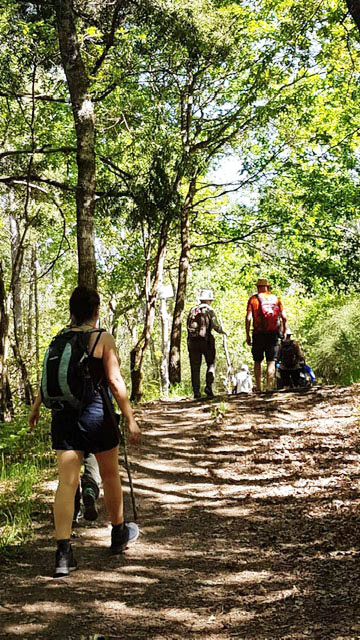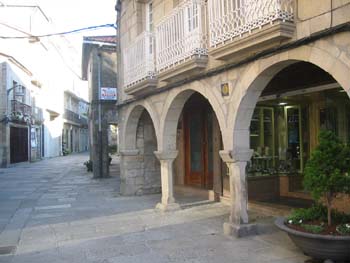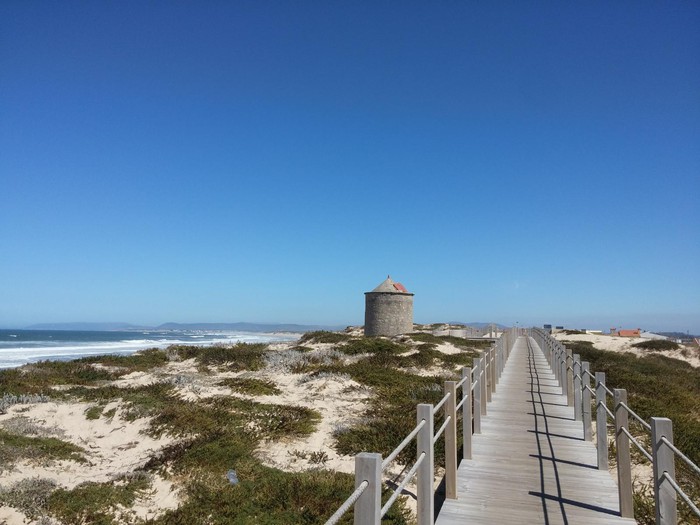WALKERS’
WORLD
Camino de
Santiago (St James Way)
PORTUGUESE ROUTE Guided Walk
 |
 |
 |
Itinerary:
Our route combines the best of the Portuguese coastal route and
the inland route, With two
guides, the group splits in two most days so one group walks a
lesser distance at a slower pace. The support vehicle is on call
nearby for
anyone who needs it.
Daily distances stated in the itinerary are approximate.
Day 1 -
Meet at the Hotel Carris Porto Ribeira at 1.00 PM. In the afternoon we have a
guided walking tour to explore the old city of Porto, a
UNESCO World Heritage site. Set on the banks of the Douro River
(River of Gold) and near the Atlantic Ocean, the city is known for its port wine
that has been shipped around the world for centuries. The riverside quarter of Ribeira is delightful with picturesque
narrow streets. Fascinating sites include the Gothic church of St Francis.
Built in 1383, its columns are lined with gilded woodwork, cherubs, rose
garlands and frenzied animals dripping with gold. Other sites
include the romantic "Street of Flowers" with its wrought-iron
balconies, many port wine cellars and the house where Henry the Navigator
(one of the great Portuguese explorers)
was born in 1394.
We spend the night in Porto at our four star hotel in an ideal location in the old quarter of the city. DINNER
INCLUDED
Day 2 -
Matsinhos to Vila do Conde This morning
our private bus takes us outside Porto to the village of Matsinhos. From
here, the Caminho route heads north so the sea is always on our left.
Some of the walking is on boardwalks that run
parallel to the sea and adjacent to glorious beaches. There is little ascent or descent and occasional bars and cafes
along the way for drinks and snacks. In the afternoon we reach the
town of Vila do Conde. The old section of the town has many
historic sites to explore for those who still have energy. Winding
cobblestoned streets pass traditional whitewashed houses and lead to Vasco de Gama Square. The Naval Museum
has replicas of Portuguese ships used by the great
Portuguese explorers in the 1600s. The 17th century Forte de Sao Joao Baptista
that once protected the town's shipyards from pirates still stands
by the harbour. But if you don't feel like exploring, the town has cafes
where you can relax over a glass of vinho verde and chat with fellow
walkers. 21KM (15KM for those who want an
easier day) DINNER INCLUDED
Day 3 -
Vila
do Conde to Esposende In the morning our bus takes us
outside the town to begin our Camino walk. Today's route is a mix of
boardwalks along the beach, quiet roads and paths through farmland and
eucalyptus forest. Esposende
is a quiet beach town where walkers can dabble their toes in the sea,
stroll the lively promenade, explore some of the town's historical
structures or just relax over a deliciously warm and lightly crisped Bola Berlim (donut)
accompanied by a meia de leite (coffee). 20 KM
(15KM for those who want an easier day) DINNER INCLUDED
Day 4 - Esposende to Viana do Castelo
Today the route moves inland through countryside and towns of historical
interest including Castelo do Nieva. It also includes the descent to the
River Nieva which is one of the most beautiful landscapes of the coastal
route. We end the day at Viana do Castelo which was an important
seaport during the Portuguese Age of Discovery.
In the days of colonial rule, goods from the Portuguese colony of Brazil
arrived in this harbour. But its history goes back much further than
colonial times. Legend says that
when Roman legions arrived here in the first century they were so
taken aback with the beauty of the landscape that they believed they were at the gates of
Paradise.
18 km
DINNER INCLUDED
Day 5 –
Today
our bus takes us a short distance inland where we return to the central
Caminho route. At Sao Roque we start at the
Roman bridge and continue on foot to Valenca passing along the shaded
banks of the River Coura, up an easy ascent to Alto San Bento, then a
pleasant descent to the Rio Pedreira and ending with a flat walk into
Valenca. The Pousada Valenca is located inside
the Fortalez (a medieval fortress) and tucked away in a tangle of
cobblestone streets and picturesque squares. The hotel has beautiful
views of the valley and river separating Portugal and Spain. It also has
an inviting swimming pool, terrace and bar for those who want to relax
after a day of walking. 21 km (16KM
for those who want a shorter walk) DINNER INCLUDED
Day 6 -
This morning we cross into Spain and at Porrino we
start the official 100 km Camino walk.
Today's route has a hill up to Monte Coronedo but the reward is a lovely view of the sea in the
distance (and perhaps a cold drink and a good lunch). Then it is downhill to
Redondela. At the end of the
walk we take a side trip of a few km (by bus) to the coast to enjoy a night
at a luxurious seaside Parador in Baiona. 16 km.
DINNER INCLUDED
Day 7 -
This morning we return to the Camino
and continue walking from Redondela. The trail passes through eucalyptus forest
and along the way we pass a
Roman milestone marking the ancient Roman road Via XIX which linked the
coast to inland towns in the era of Roman occupation. We
cross the Rio de Vigo to Ponte Nova and in the afternoon have a lovely rural walk
to Pontevedra. This
is a lively Galician provincial capital with a delightful medieval area.
18 km DINNER INCLUDED
Day 8 – Today is an easy day. The morning is free to explore the
delightful old section of Pontevedra.
Sights
include the pilgrim chapel in the Praza da Peregrina, the historic Zona
Monumental (old city), the Praza de Leña, the market, and the Alameda ( a
promenade along the river). Or you may prefer a relaxed morning and lunch
at one of the many cafes. The
most famous product in the typical gastronomy of Pontevedra is shellfish
which is always accompanied by the local wine, Albariño.
In the afternoon we have an easy Camino walk from Pontevedra on small country
roads and tracks. There is a gentle climb at San Mauro and from here we
return (by bus) to Pontevedra for the night. 13
km
Day 9 -
Today we walk from San Mauro to the spa town Caldas de Reis
"The Royal Spa" where medieval pilgrims and kings both enjoyed
bathing their feet in a fountain fed by
natural hot spring water.
Caldas de Reis has been known since Celtic times for the healing
properties of the thermal
waters gushing from its ground. Ancient
monuments remain here and in a thermal spring we find an altar from the pre-Roman
age which is dedicated to the native god Edovio. Caldas de Reis was a major spa for Romans and has an abundance of Roman remains
including a Roman bridge that is still used.
In Reconquista times the town was known as Rex Calda and King Alphonso
VII was born here. Today it
is considered to be the garden and health resort of Galicia and there is
time to enjoy it before we move on.
Day 10 - In the
morning we return to Caldas de Reis and from here continue our Camino walk
to Padron. The route is on
quiet country roads and natural pathways with a few gentle climbs.
The name Padron means "mooring stone". Just up river
is Iria Falvia which legend claims is where St James' body arrived in Spain
two thousand years ago. Under the altar in Padron's
Santiago Church one can see what is said to be the
original mooring stone for St James' boat. The legend
is that St James preached the gospel in Iberia as well as in the Holy Land
and that after his martyrdom his disciples carried the body by sea
to Iberia where they landed at Padron and took it inland for burial.
Historians agree this is possible.
Our accommodation tonight is the Pazo de Lestrove.
A “pazo” was a country estate of the Spanish nobility and usually
consisted of a stately manor house or castle surrounded by gardens and
outbuildings This pazo was
once a country escape for the bishops of
Santiago and has been converted to an atmospheric country hotel
which t is known for
its excellent menu of local dishes.
Day 11 - Our final walk is along pretty country lanes passing
through Iria Flavia as well as other small villages and hamlets before
arriving at the baroque sanctuary of A Esclavitude. On a hilltop to the
left stands the mysterious, abandoned ruins of the hillfort Castro Lupario
and a few kilometres later we come to the oldest wayside cross in Galicia.
As we near Agro dos Monteiros it is now possible to see the towers of
Santiago Cathedral. Finally, the Camino passes by the ruins of a castle
and enters Santiago. It is tradition
to head for the Cathedral, collect the Compostela certificate then relax and
celebrate.
 |
Itinerary |
| Frequently Asked Questions | |
| Contact us and booking information | |
| Cost and included | |
| Where we Stay | |
| Camino Home Page | |
| Walkers World Home Page |